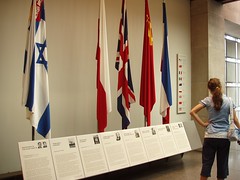Touring the United States Holocaust Museum
The United States Holocaust Memorial Museum in Washington D.C. is a permanent exhibition that spans three floors. The museum conjures a narrative history that uses more than 900 artifacts, 70 video monitors, and four theaters that include historic film footage and eyewitness testimonies.
By Megan Seigh
Staff Writer
The United States Holocaust Memorial Museum in Washington D.C. is a permanent exhibition that spans three floors. The museum conjures a narrative history that uses more than 900 artifacts, 70 video monitors, and four theaters that include historic film footage and eyewitness testimonies.
“I had wanted to visit the museum when I was in D.C. about 4 years ago, but this was the first time that I went into it,” said junior Chris Dufalla. “I found that the exhibits displayed a very powerful message: learn from history or else it will repeat itself.”
Seton Hill University (SHU) took a group of 40 through the museum on their annual Washington D.C. trip.
The tour is mostly self-guided and can take an average of 2 to 3 hours to walk through the building. It was recommended that only visitors 11 years of age and older visit the museum.
This experience was to help benefit Sr. Lois’s Senior Seminar class, staff from the SHUÕs National Catholic Center for Holocaust Education (NCCHE) and others who were interested in gaining more knowledge from this tragedy.
Members of the group expressed their interest and the joy in seeing what the powerful exhibition had to offer.
“The museum was very moving and educational,” said junior Laura Gonnella. “Each time I visit, I find something new that I missed before. I definitely recommend visiting this museum.”
“It was a very memorable experience even though I’ve been there a few times before,” said sophomore Jessica Orlowski. “It helps me to put everything into perspective and I think everyone should go there at least once.”
The entire exhibition is divided into three parts, the Nazi Assault, Final Solution and Last Chamber. The narrative begins with the images of death and destruction witnessed by American soldiers during the liberation of Nazi concentration camps in 1945.
“The signs on display prompting the museum-goers to ‘think about what they have seen’ were intriguing,” Dufalla said. “They reinforced the notion that the very same elements that led to the Holocaust (discrimination, racism, and hate) are still alive and destructive today. Overall, I found it to be a very enlightening and perspective broadening experience.”
The museum is dedicated to those who lost their lives during the Holocaust and how everyone must remember their story. The word holocaust, which means “sacrifice by fire,” was endured by those who German authorities targeted as Òracial inferiorityÓ such as: Gypsies, the disabled, some Slavic people, people who were on political or behavioral grounds, communists, Jehovah’s Witnesses, homosexuals, and Jews. This persecution, which was systematic, bureaucratic, and state-sponsored, resulted in the murder of approximately 6 million Jews by Nazi regime.
There is an alarming rise in Holocaust denial and anti-Semitism today. This denial is being faced all around the world, even in the homeland of the Holocaust. This is happening during an approaching time when Holocaust survivors will no longer be alive.
An example of this hatred happened recently when the museum was struck with tragedy a few months ago and continues to mourn the tragic passing of Officer Stephen Tyrone Johns, who died heroically in the line of duty on June 10 protecting visitors and staff.
This is a living memorial to the Holocaust and it inspires many people worldwide to confront hatred, promote human dignity, and prevent genocide. This museum is located among our national monuments on the National Mall. It also provides powerful lessons about freedom and the myth of progress. This is supposed to inspire and encourage people to act in a way that they will respond to the challenges of the world today.
